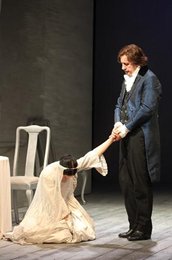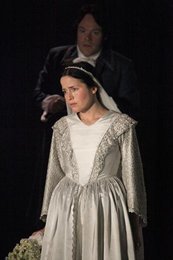The history of stage adaptations of novels is long and illustrious, and the reworking of the writings of the Brontës includes stage, film, dance and operatic treatments, and Ireland seems to have a particular propensity for such literary theatrical versions. It is not surprising, then, that Alan Stanford’s dramatic rendering of this 19th century prose work has re-appeared. It is, after all, very much within the remit of The Gate.
 Charlotte Brontë’s tale of an orphaned girl who lands on her virtuous feet after many perils, is larded with Victorian favourite touches – a Gothic mansion, a Byronic hero, a mad wife in the garret, miscegenation, and dark mysteries brought home from the exotic colonies. The Gate’s production, under the direction of Alan Stanford, who also adapted the novel for the stage, is lavish and fields a large cast, many of whom are still required to play multiple roles. Bruno Schwengl’s set is cast in fashionable grey tones, lit to sombre or luminous effect to reflect the vagaries of the heroine’s plight. Schwengl also includes a sunset backdrop in one scene against which the retreating, silhouetted figures are reminiscent of that other tale of a feisty heroine – Gone with the Wind. The costuming by Léonore McDonagh is both meticulously of the period and artfully chosen to highlight the rank of the characters from high to low.
Charlotte Brontë’s tale of an orphaned girl who lands on her virtuous feet after many perils, is larded with Victorian favourite touches – a Gothic mansion, a Byronic hero, a mad wife in the garret, miscegenation, and dark mysteries brought home from the exotic colonies. The Gate’s production, under the direction of Alan Stanford, who also adapted the novel for the stage, is lavish and fields a large cast, many of whom are still required to play multiple roles. Bruno Schwengl’s set is cast in fashionable grey tones, lit to sombre or luminous effect to reflect the vagaries of the heroine’s plight. Schwengl also includes a sunset backdrop in one scene against which the retreating, silhouetted figures are reminiscent of that other tale of a feisty heroine – Gone with the Wind. The costuming by Léonore McDonagh is both meticulously of the period and artfully chosen to highlight the rank of the characters from high to low.
Of particular interest in this production is the excellent work of a number of teenaged actors who hail from the Independent Theatre Workshop and other drama and dance training programmes in both Ireland and the UK. Some of the youth are double cast in the more arduous roles. Opening night saw Chloe McCormack Grant as the girl Jane, and her performance was both refreshingly upstanding and simply beautiful, setting a contrast to the debased nature of some of those who would determine her fate. The role of Helen Burns, Jane’s steadfast friend and the victim of the institutionalised system in which Jane finds herself, was carried off with a grace which avoided any excess that might attach to the death scene of a child. However it was Andrea Corr as the adult Jane whom many in the audience were there to see, and although Corr managed a balance of dignity and spunk, her appearance and coiffure sometimes produced an unwanted Grant Wood element which was distracting. Directorial choices were apparent in her uncharacteristic foot-stamping scene in which she bemoans the likelihood of losing Rochester to a more glamourous rival. Surely not the reaction one would expect from Our Jane.
 Stephen Brennan plays an irascible, petulant Rochester, a complex and unlikeable man whose bad choices, even in the original, are never sufficiently explained. Stanford’s adaptation here is true to the mark, and it also elides or eliminates subplots too various and co-incidental in the novel. The pitch of melodrama is avoided by the director and the cast for the most part, although tell-tale titters from the audience suggested that the rendering was not completely successful in this regard. Owen Roe’s blaggardly Mr. Brocklehurst struts his little fiefdom with blithe disdain for the well-being of his charges. He becomes the embodiment of self-interest modern audiences know from various Dickensian workhouse villains (or even more modern varieties on the nightly news). Catherine Walker stretches seamlessly between her dual roles as the objectionable Blanche Ingram who tosses her frivolous cap at Rochester, and the radiant goodness of Diana Rivers whose family harbours Jane in her darkest hour. Equally adaptable in dual roles is Noelle Brown as Blanche’s intensely objectionable mother and as Jane’s sainted teacher, Miss Temple.
Stephen Brennan plays an irascible, petulant Rochester, a complex and unlikeable man whose bad choices, even in the original, are never sufficiently explained. Stanford’s adaptation here is true to the mark, and it also elides or eliminates subplots too various and co-incidental in the novel. The pitch of melodrama is avoided by the director and the cast for the most part, although tell-tale titters from the audience suggested that the rendering was not completely successful in this regard. Owen Roe’s blaggardly Mr. Brocklehurst struts his little fiefdom with blithe disdain for the well-being of his charges. He becomes the embodiment of self-interest modern audiences know from various Dickensian workhouse villains (or even more modern varieties on the nightly news). Catherine Walker stretches seamlessly between her dual roles as the objectionable Blanche Ingram who tosses her frivolous cap at Rochester, and the radiant goodness of Diana Rivers whose family harbours Jane in her darkest hour. Equally adaptable in dual roles is Noelle Brown as Blanche’s intensely objectionable mother and as Jane’s sainted teacher, Miss Temple.
The transition from stage to page is facilitated by an onstage narration by Jane in old age in which Deirdre Donnelly provides a gravitas and equanimity, a luxury that the characters caught up in the quotidian at Lowood School and Thornfield Hall cannot allow themselves. Voice over is tricky, and on screen usually a distraction. Though exceedingly old-fashioned in terms of stage history, this choice on Stanford’s part suited the genre and period. It was also heartening to see a number of major actors doing their bit to staff this large cast – Barbara Brennan as a most amiable Mrs. Fairfax and Barry McGovern gamely filling in where needed.
Jane Eyre is not for those seeking excitement or innovation in the theatre. For both Brontë devotees and Corr fans it’s a great night out; there are occasional longeurs for the rest of us. The show continues until mid-January and is well-suited fare for the holiday season.
Christina Hunt Mahony, who directed the Center for Irish Studies at the Catholic University of America, now lectures in Trinity College. She is the editor of Out of History: Essays on the Writings of Sebastian Barry.